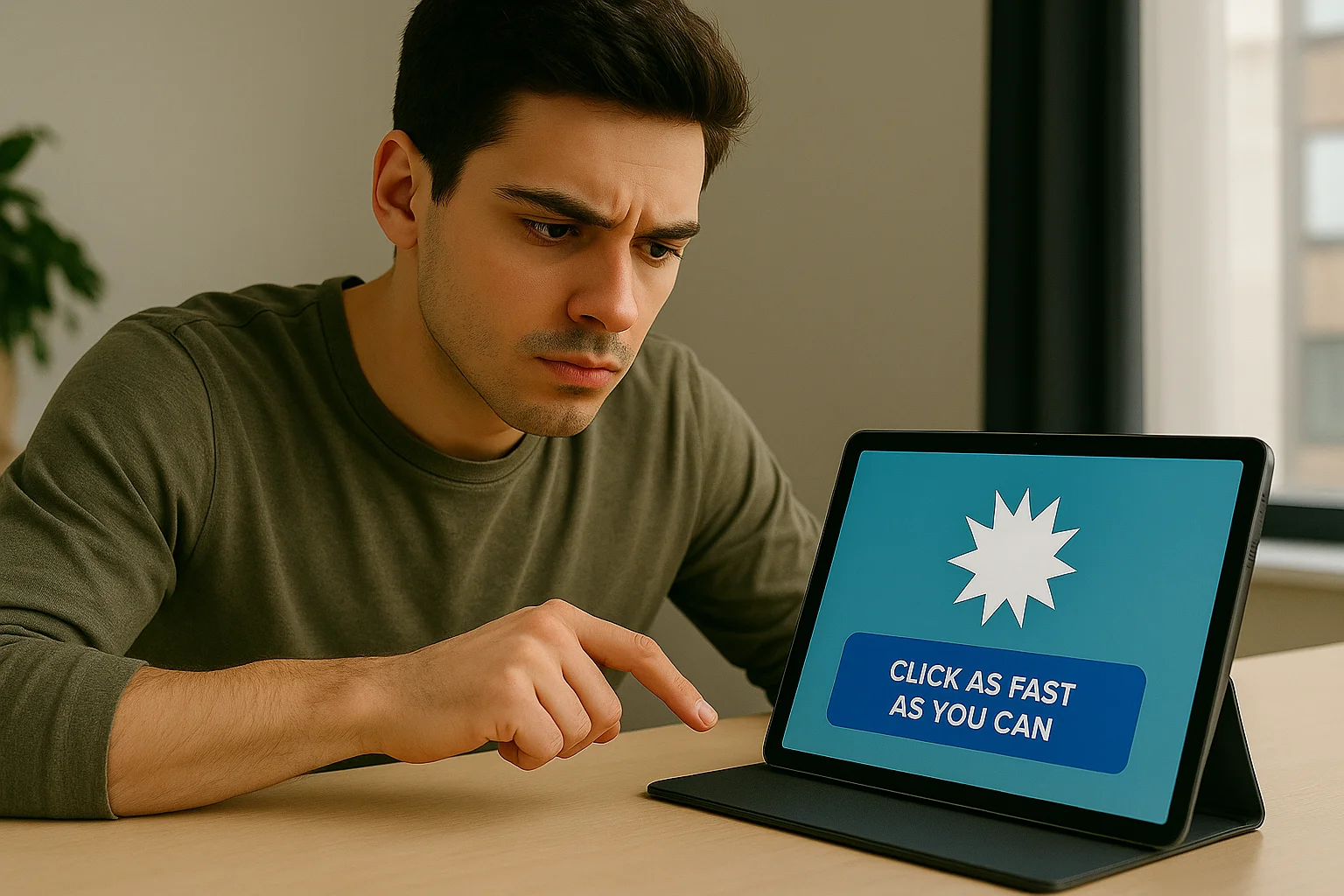Think about the last time you had to slam on the brakes because a car stopped suddenly in front of you, or when you tried to catch a glass that slipped from the edge of the table. In both cases, your reaction time (the split second it takes your brain to notice something and your body to respond) was the deciding factor. Reaction speed is one of these skills we rarely think about, however, the same skill affects your safety, performance, and even confidence in everyday life.
That is why the reaction time test became such a popular tool. It is a simple way to measure how quickly you respond to a stimulus, like a flash of light or a sound cue. For most people, the average reaction time hovers around 200–250 milliseconds. That might not sound like much, but in real-world situations, shaving off just 50 milliseconds could mean avoiding an accident, winning a race, or catching that falling glass before it hits the floor. The good news is the reaction time isn’t set in stone. With the right kind of training, you can improve it.
But here’s the catch: many people don’t run these tests correctly. Thus, today we would like to explore the topic in detail and take a closer look at what exactly a reaction time test is and where it shows up in real life.
What Exactly Is a Reaction Time Test?
At its core, a reaction time test checks how quickly you can respond to a specific stimulus. Imagine someone clapping their hands and you hitting a button as soon as you hear it — that is a basic form of the test. Today, most reaction time tests are digital, using a screen and a simple “click as fast as you can” setup.
Here’s where reaction time tests are often used:
| Field | Why It Matters |
| Sports | Athletes rely on quick starts and fast responses, like sprinters reacting to the gun. |
| Medicine | Doctors sometimes use tests to track cognitive health or recovery after brain injuries. |
| Education | Helps children strengthen focus, attention, and decision-making skills. |
| Everyday Life | From safe driving to gaming, fast reactions make daily decisions easier and safer. |
One fascinating fact: astronauts also train their reaction times. In space, every millisecond counts. Imagine a sudden equipment alert or a navigation issue — the faster the crew can react, the better their chances of handling it safely.
So, should you care about your own reaction time if you’re not an athlete or an astronaut? Absolutely, because knowing and testing your reaction speed is like checking your pulse or blood pressure — it’s a snapshot of how your brain and body work together. Regularly testing yourself can highlight changes over time and remind you that your mind, just like your muscles, benefits from consistent training.

Common Mistakes People Make When Testing Reaction Time
Estimating your reaction time sounds simple: click as soon as the screen flashes, tap the button when the sound plays. Sounds easy, right? But in reality, many people end up sabotaging their own results without realizing it. Here are the most common mistakes that can throw your scores way off.
Mistake 1: Ignoring the Test Conditions
A lot of people take a reaction time test “on the go” — in a noisy café, while chatting with a friend, or right after an energy drink.
- Why this is a problem: Background noise, phone notifications, or even caffeine can all speed you up or slow you down artificially. You are not measuring your natural reflexes, but your ability to cope with distractions.
- Tip: Treat the test like a mini-experiment. Choose a calm, quiet space, and if possible, take it at the same time of day. That way, your results reflect you, not the chaos around you.
Mistake 2: Skipping Preparation
Imagine testing your sprint speed right after rolling out of bed. You wouldn’t expect a personal record — yet people do the same with reaction time.
- The issue: Fatigue makes your brain sluggish. In fact, even some studies show that deprivation of sleep can slow your reactions even more than having a small amount of alcohol in your system.
- Life hack: Do a quick “warm-up” before testing. This could be as simple as a 2-minute breathing exercise, stretching your hands, or even following a moving object with your eyes. Think of it as waking your brain up so it can perform at its best.
Mistake 3: Testing Too Often
When people get excited about tracking progress, they sometimes go overboard, repeating the test every 10 minutes.
- Why it backfires: Just like your muscles, your brain gets tired. Over-testing leads to slower results and unnecessary frustration.
- Pro tip: Test 1–2 times a day at most. Keep a simple log of your scores, then compare weekly trends instead of stressing over every single click. That way, you’ll see real improvement without burning yourself out.
Mistake 4. Misinterpreting the Results
One of the biggest traps people fall into with reaction time tests is thinking a single score reveals everything about how “fast their brain is”. It doesn’t. Your reaction speed does not stand still — it changes depending on a wide range of factors.
- Fatigue – A bad night’s sleep can easily add extra milliseconds to your response.
- Stress – When your mind is overloaded, your body’s signals don’t fire as cleanly.
- Time of day – Many people are naturally sharper in the morning and slower at night.
So, if you take a test after pulling an all-nighter or during a stressful workday, don’t panic if your score drops. It doesn’t mean you’ve suddenly lost your “edge”. It simply reflects your current state.
Mistake 5. Forgetting the Training Part
Here is another misconception: that just taking the test over and over will make you faster. It won’t. A reaction time test is like a stopwatch — it measures, but it doesn’t train.
If you actually want to improve, you need practice. Luckily, training your reaction speed can be fun:
- Physical drills: Try quick ball games, ping pong rallies, or even catching objects mid-air.
- Cognitive drills: Use apps designed for brain training.
This is where tools like Mind Elevate come in handy. Instead of dry repetition, it turns reaction training into mini-games. For example Meteor Escape challenges you to dodge falling objects, boosting attention and coordination, while Rocket Race pushes you to respond quickly under time pressure (strengthening both focus and reaction speed).
Lifehack: Mix physical and digital training. Kick a ball against a wall one day, then test your reflexes with a game the next. The variety keeps your brain and body adapting, which accelerates improvement.

Testing the Right Way
Finally, we should say a reaction time test is a useful tool, but only if you use it wisely. Avoiding the five common mistakes we’ve covered means you will get more honest results, as well as real benefits from the process. Treat reaction time testing as a way to better understand how your brain and body work, not as a competition.
And remember: the real magic happens when you combine testing with training. That’s when you’ll notice yourself reacting faster—not just on a screen, but in everyday life.




